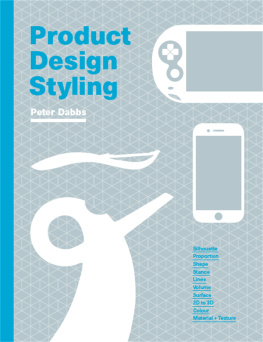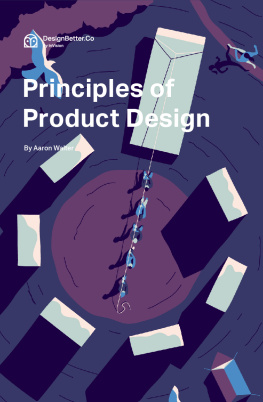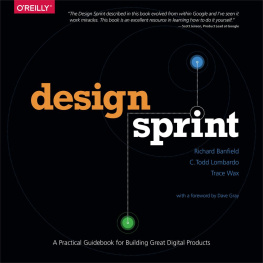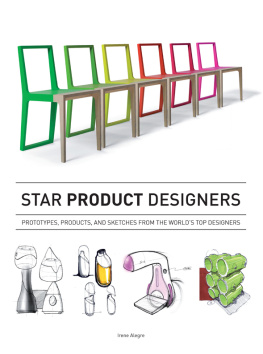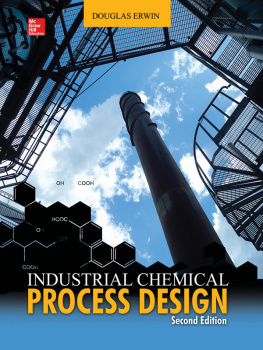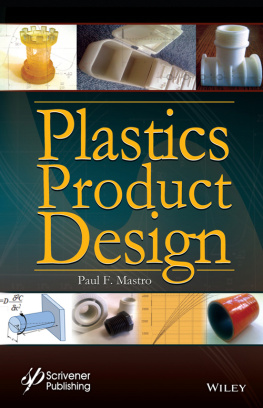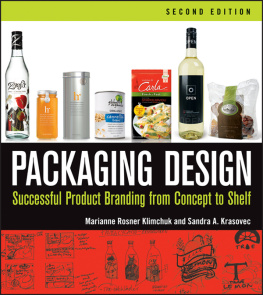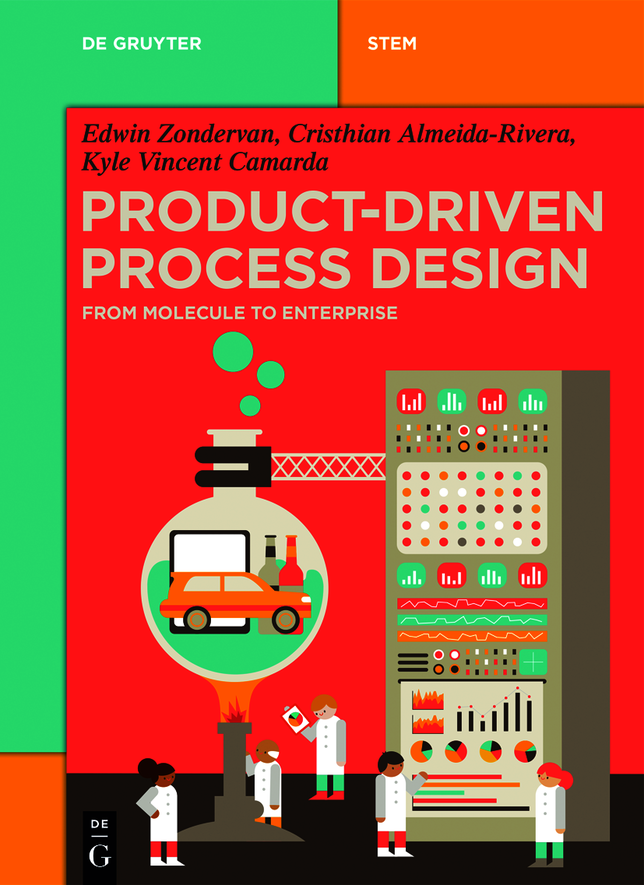ISBN 9783110570113
e-ISBN (PDF) 9783110570137
e-ISBN (EPUB) 9783110570199
Bibliographic information published by the Deutsche Nationalbibliothek
The Deutsche Nationalbibliothek lists this publication in the Deutsche Nationalbibliografie; detailed bibliographic data are available on the Internet at http://dnb.dnb.de.
2020 Walter de Gruyter GmbH, Berlin/Boston
To Prof. Dr. ir. Peter M.M. Bongers (),
with whom we shared the passion for
product-driven process synthesis
but unfortunately cannot be with us today
to witness the result of our vision
To all people who guided, excited and contributed to the creation of this work:
All students and colleagues who provided content through discussions!
My son, Victor Haim Zondervan, who is the driving force of all activity in my life!
EZO
To all the people who helped and inspired me throughout this journey:
Prof. em. ir. Johan Grievink, my mentor and former supervisor, from whom I learned the most important lessons of process design,
Patricia, my wife and life partner, and my two precious peas Lucia and Cristina, who are my reasons for being,
my parents, who raised me to become persistent and to stay true to my beliefs, and
the design practitioners out there, who are committed to redesigning this world and making it a better place for everyone.
CAR
To all the people who supported and inspired me: my family, my colleagues and my students
KVC
Foreword
The chemical process industry is subject to a rapidly changing environment, characterized by slim profit margins and fierce competitiveness. Being able to operate effectively at reduced costs and with increasingly shorter times-to-market is the common denominator of successful companies and corporations. However, attaining this performance level is not a straightforward or trivial issue. Success is dependent on coping effectively with dynamic environments, short process development and design times and, last but not least, continuously changing consumer (or end-user) needs or expectations.
It is now well established by industry and academia that the focus of the chemical process industry has shifted from a process-centered orientation to a product-centered one. In fact, during the last decades we have experienced how the commodity chemical business gradually released its dominating role towards higher-added value products, such as specialty chemicals, pharmaceuticals and consumer products. These products are not only characterized by their composition and purities, but also by their performance or functionality against the satisfaction of a need or desire of the consumer.
Manufacturing such products in a responsible and sustainable way imposes technical challenges and requires the development of research and development capabilities.
Addressing the dynamic challenges of a consumer-centered market requires the development of an appropriate design methodology. Such methodology should provide the right tools and framework to solve the multi-dimensional and multi-disciplinary nature of design problems, where multiple stakeholders, objectives and types of resources characterize the design space on various time and length scales.
Aiming at a more structured approach toward the synthesis of a consumer-centered product and their manufacturing processes, in this book we propose a methodology that exploits the synergy of combining product and process synthesis workstreams. This methodology, the Product-driven Process Synthesis (PDPS) method, is supported by decomposing the problem into a hierarchy of design levels of increasing refinement, where complex and emerging decisions are made to proceed from one level to another.
This book is structured in two distinctive sections. The first section follows the structure of the proposed methodology, focusing on one level in each chapter, while the second section provides a comprehensive and up-to-date review of the technical areas that reside in the core of chemical and process engineering.
The contents of all the chapters of this book are support by a set of examples and case studies. By addressing industrially relevant and real-life cases the reader (e.g., design practitioners or designers-in-the-make) is exposed to the challenge of design, which hovers over multiple design spaces and with broad time and space scales From molecule to enterprise.
Enjoy!
Prof.dr.ir. Edwin Zondervan
Dept. of Production Engineering
Bremen University Germany
Dr. ir. Cristhian Almeida-Rivera
Organisation for the Prohibition of Chemical Weapons (OPCW)
The Netherlands
Prof. Dr. Kyle Vincent Camarda
School of Engineering
Chemical & Petroleum Engineering
University of Kansas
United States of America
Part I Process Design
Introduction
1.1 The current setting of process industry
We cannot solve our problems with the same thinking we used when we created them.
(Albert Einstein, 18791955)
The current chemical process industry (CPI) is subject to a rapidly changing environment, characterized by slim profit margins and fierce competitiveness. Rapid changes are not exclusively found in the demands of society for new, high quality, safe, clean and environmentally benign products (). They can also be found in the dynamics of business operations, which include, inter alia, global operations, competition and strategic alliances mapping. Being able to operate effectively at reduced costs and with increasingly shorter times-to-market is the common denominator of successful companies and corporations. However, attaining this performance level is not a straightforward or trivial issue. Success is dependent on coping effectively with dynamic environments, short process development and design times and, last but not least, continuously changing consumer (or end-user) needs or expectations.
It is now well established by industry and academia that the focus of the CPI has shifted from a process-centered orientation to a product-centered one (). In fact, during the last decades we have experienced how the commodity chemical business is gradually releasing its dominating role towards higher-added value products, such as specialty chemicals, pharmaceuticals and consumer products. Chemical industry has been gradually concentrating its activities and streamlining its assets towards value creation and growth by engaging in the manufacture of high-value chemical products. These products are not only characterized by their composition and purities, but by their performance or functionality against the satisfaction of a need or desire of the consumer.
Among process industries, those engaged in the manufacture and marketing of Fast-Moving Consumer Goods are subjected to an even more increasing pressure. The market is not only extremely dynamic and changing, but is also characterized by the predominant role of consumers, which have become more critical, demanding and conscious about their choices since the 1980s. Todays customers are more connected, sceptical about the value-for-money proposition they receive and sophisticated in their demands with ever-increasing expectations of their product and service providers ().
In this particular market segment, all leading FMCG companies are rapidly transforming from general manufacturing hubs of loosely connected products to companies delivering health, wellness and nutrition in a sustainable manner. Manufacturing in a responsible and sustainable way products within those strategic areas imposes technical challenges to work on and requires the development of research and development capabilities. These challenges and capabilities have the clear aim of delivering a product with all associated benefits (financial performance, environmental and societal impacts) at a short time-to-market and at a reduced manufacturing expenditure. Finding and creating business opportunities to be brought successfully to the market () is the response of leading companies to this rapidly changing environment. In fact, from a Design Thinking perspective, true innovations reside at the intersection of consumer desirability, technology feasibility and financial viability. A key activity in this innovation-driven space is the actual creation of the conversion or manufacturing system (


